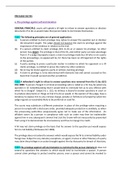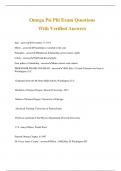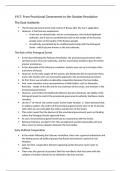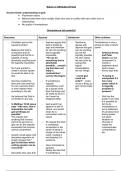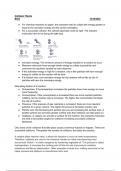CIV Consolidation Notes
SECTION 1: PRE-ACTION
[Pre-action protocols] (In permitted materials, including the Professional Negligence Protocol)
Need to be able to know how to answer a question advising what steps are required/what sanctions there are
APPLY these to the facts what would you tell client in practice!
Tabbing = ORANGE!
Consider:
PCR; objectives; merits of claim; worth suing; ADR/mediation; funding; plan of action
General provision for pre-action behaviour in cases not covered by a specific protocol.
PD for pre-action conduct must be observed
o Parties should exchange sufficient information allowing them to understand each other’s position and make informed
decisions about settlement; need to respond in reasonable time
o Full written response in Para 7.2 of the PD
o C should not start proceedings until the time for D’s response has lapsed + parties to consider ADR; stock-taking
Sanctions if don’t follow:
o Costs, stay, interest, CM decisions
o Court to look at overall effects and is not concerned with minor breaches
CPR Pre-Action Disclosure – 31.16
o Applicant has to show that a claim ‘may or may well be made’; applicant does not have to show a good cause of action
o CPR31.16(3)(a) must bel ikely to be a party in proceedings in due course but no requirement that subsequent
proceedings be brought (Black v Sumitomo)
o ONLY ORDERED IF PROPORTIONATE – fishing expeditions not allowed
Part 36 offers
o NOT confined to once proceedings have begun – can be made at pre-action stage
o Consequences of not accepting same as post-action offer
SECTION 2: ACTION
Tabbing on counting time etc = top left yellow
[Introduction]
SOC = doc which sets out the basis of a party’s claim against other parties – sets out facts relied on and allegations made in support
of that party’s case (not about law/evidence/arguments)
Includes: CF, POC, Defence, Counterclaim, Defence to Counterclaim, Reply (non-obligatory)
I. CLAIM FORM & PARTICULARS OF CLAIM
[Claim form]
[Time frame: CPR 2.8 6.14]
[Choice of court: CPR 7 Practice Direction]
Jurisdiction not a problem – High Court and County Court have concurrent jurisdiction over tort claims
Value of claim ≤ £100,000 County Court
Value of claim > £100,000 County Court or High Court. Factors relevant to choice:
o Financial value of claim and amount in dispute; and/or
o Complexity of facts, legal issues, remedies/procedures involved; and/or
o The importance of the outcome of the claim to the public in general
If any of these are answered in the alternative, good basis for C believing that the claim ought to be dealt with by
a High Court Judge
[Issuing the claim form]
C’s solicitors has to take/send to the court copies of the claim form:
o (a) one copy to be kept at the court
o (b) one copy for service on each defendant; and
o (c) one copy for themselves
[Service of the claim form]
NB. ‘Service’ of claim form really means take steps towards service – see below for points on service itself
Have 4 months after issue to serve the claim form i.e. put it in the post box by the last day of the 4 months
o = completed the relevant step toward service
o Strict rule (NB. 6 year limitation period – people shouldn’t be pushing that 6 years further). V rare that this 4 month rule
will be extended
But won’t have served the claim form – see below for this
NB. If you serve POC 14 days later, that POC also have to be served within that 4 month period
So best thing to do if you want as much time as possible to consider the detail of your claim is to issue claim form only (as opposed
to issue and serve CF/POC as one doc, or issue and serve CF and serve POC 14 days later) you get the full 4 months
1
,[Rules of service: CPR 6] Hugely examinable! Show your working if you get a LFQ on timings – and see summary chart (handwritten)!
Serving other side notice of document
[Methods of service]
[Rules for all documents: CPR 6]
See CPR 6.3
[Other rules that impact on the method of service]
[Service on companies: CPR 6.3]
o Can bypass CPR rules by serving acc to CA 2006 – s 1139: serving by leaving it at/sending by post to registered office.
Doesn’t say anything about fax/email
[Solicitor authorised to accept service? CPR 6.7]
o Where this is the case, you have to serve on the solicitor, not D
[Alternative service: CPR 6.27 (CPR 6.15 for CFs)]
o Can’t find the person, can’t serve by post etc go back to court and list all the things you’ve tried to do and ask the court
to authorise service by an alternative method e.g. putting advert in local paper (last resort)
[Dispensing with service? CPR 6.28 (CPR 6.16 for claim forms)]
o Court can dispense with service but generally done where e.g. amendments that have been argued upon in court where
other side knows what the amendments are
[Irregular service: CPR 3.10]
o V rarely used, esp v rarely used wrt claim forms
o Court overlooking procedural irregularities
[Additional rules for service of claim forms]
[Service of claim form by a contractually agreed method: CPR 6.11]
o If contract specifies a particular method, then have to follow that method
[Late service of a CF]
o Must generally be served within 4 months and rules on curing irregularities cannot generally be used on CF
[Date of service]
Why important? Lots of time limits run from this date
Rules re date of deemed service are different for CFs and other docs
[Claim forms]
The deemed date of service of CF is always the second business day after completion of the relevant step
See CPR 7.5 for table showing what the ‘relevant steps’ are
[Other documents]
Vary according to the method of service – see CPR 6.26 for table
Note the 4:30pm rule!! Would be considered to be served the next business day
[Things to bear in mind]
‘Business day’ is defined as any day except:
o Saturday
o Sunday
o Bank holiday
o Good Friday
o Christmas Day
Rules apply strictly and deemed dates of service cannot be rebutted by evidence of actual service to the contrary: Godwin
What do you do if the claim form and particulars are served together? Unclear. But always use the one that’s earlier thus claim
form rule would take priority
[Address for service]
Rules differ for CFs and other docs
[Claim forms]
Where the solicitor is authorised: see CPR 6.7
Where the solicitor is not authorised
o Party should give address
o If party does not, see CPR 6.9
Usual/last known address
Kilgour: knew that premises were empty, served there anyway. Court: bit lazy, could have looked them up and
found their address rules amended to say that you have to take reasonable steps to find D’s current address
But if having taken reasonable steps you can’t find address, then you can serve even if you know those premises
are empty
(See CPR 6.9.3-6.9.6)
Serving on a co registered office (as above)
[Other documents]
Where solicitor acting – address of solicitor: CPR 6.7
Where no solicitor acting – address given on the document (unless doc is to be served personally/court orders otherwise)
II. ACKNOWLEDGMENT OF SERVICE, AND/OR, ADMISSION/DEFENCE/DEFENCE AND COUNTERCLAIM
[The defendant’s response]
[Options]
Defendants must do one of three things to respond:
2
, o (1) Admit part/all of the claim – CPR 14
Not going to be seeing admissions on LPC – would have settled. V infrequent
o (2) File a defence – CPR 15; or
o (3) File an acknowledgment of service (if it needs longer to prepare the defence) buys an extra 14 days
Most common – file AOS and then file defence later
Defence = drafting = adopt definitions ; require proof if no knowledge of TP contract & prove no other altrntv
o SAY what you want proof of for defence
o In the circumstances, it is denied that the Claimant is entitled to the relief claimed or any relief
o It is denied that the Claimant is entitled to interest as claimed in paragraphs 10 and 11 of the PoC
[Time frame: CPR 2.8 6.26] This will come up in the exam!!
In sum: 14 days of POC OR 28 days of POC if acknowledgment
The defendants must admit/file defence within 14 days of service of the particulars of claim, UNLESS
…they’ve served an acknowledgment of service within that time frame, in which case the defendant has an extra 14 days in addition
to the normal period for serving a defence i.e. 28 days after service (last day you could’ve acknowledged) of the POC (time period is
calculated by reference to the date upon which the particulars of claim are served; not by reference to when the acknowledgment of
service is filed/served)
[Counting time: CPR 2.8-10]
(1) If the period of time = 5 days or less, do not count:
o Saturdays
o Sundays
o Bank holidays
o Christmas Day; and
o Good Friday
(2) If the period ends on a day the court office is closed, the act shall be done in time if done on the next day that the court is open
(3) ‘Days’ = clear days i.e. excluding the day on which the period begins and, if the end of the period is defined by reference to an
event (e.g. a court hearing), the day on which that event occurs
o You only have a clear day rule at the end where there is an event i.e. something before a judge
[Considerations if defendant doesn’t respond]
If the defendants do not respond, claimant has the following options:
[Extensions]
[Where D can’t serve defence in time]
o D + C can agree an extension of up to 28 days: CPR 15.5 BUT only if other side rings you up do you extend time!!!!
What would solicitor say if legitimate reason? C can’t make decision off own back – must seek instructions from
client and revert to you
Client will probably say yes; otherwise have to go to court, other side may win, client would have to pay legal
costs for both sides
o D doesn’t have to but have to be prepared to justify it if you don’t – court will expect you to be cooperative
o Court must be notified in writing
[If D still not ready after agreed extension]
o D must apply to court for more time by issuing an application notice (preferably before expiring of time for filing the
defence) which will be served on C
o Both sides then required to attend before Master to argue over how much time should be given
o Court will consider the overriding objective in deciding whether extension should be granted
o Where application is made retrospectively (after deadline has passed), court = likely to treat application as app for relief
from sanctions under CPR 3.9
[Automatic extension on application for summary judgment]
o If either party applies, then D need not file a defence before the application is heard: CPR 24.4(2) i.e. the time limit is
automatically extended
[Judgment in default: CPR 12]
C may apply for this if it’s a claim where judgment in default = available
If successful, C has won the case without it going any further – obtained without consideration of the merits of the case. Doesn’t
even go in front of the judge. But not the end of the matter – see below setting aside
Must show:
o Particulars have been served (hence certificate of service on the court file)
o Timing for filing a defence/acknowledgment of service (taking into acct extensions) has expired
o Claim hasn’t been admitted/satisfied
o No application for summary judgment/strike out has been made
o CPR PD 12 – 4.1
Procedure:
o [Money claims – specified sum]
C may file request for judgment (a court form)
Court will enter judgment for:
The amount sought; plus
Fixed costs; plus
Interest accrued to the date of judgment
o [Money claims – unspecified sum]
3
, C may file request for judgment (a court form)
Court will enter judgment for a sum to be decided by the court plus costs, and will set a timetable leading up to a
hearing at which that sum will be decided
o [Non-money claims]
Request for judgment procedure cannot be used; C must make app in usual way under CPR 23
Hearing will be listed at which the court will consider the app
[Setting aside a default judgment: CPR 13]
Court has wide powers to set aside a default judgment bc not decided on merits
Can be set aside by app of D/by court of its own motion
[Automatic setting aside if judgment was wrongly entered: CPR 13.2]
o Time limit not expired
o Acknowledgment of service/defence had been filed on time
o Summary judgment/strike out had been applied for
o D had satisfied claim/admitted claim/requested time to pay
[Otherwise at discretion of court: CPR 13.3] Court may exercise discretion if:
o (1) D has real prospect of successfully defending the claim; or
Burden of proof is on D to show this: Patel
Whether real prospect of success and that justice should be done = primary consideration: Thorn
o (2) It appears to the court that there is some other good reason why judgment should be set aside/varied/D should be
allowed to defend (Berezhovksy)
Thorn – should also take into account:
Length of delay in responding to the claim (and reasons for the delay)
Any failure to provide an explanation for the delay (factor but not always a reason to refuse setting
aside); and
Whether any prejudice will be suffered by C
Redbourn – must also consider:
How promptly D makes its application to set judgment aside (CPR 13.3(2))
Consider 3 stage test on an application for relief from sanctions as set out in Denton
[Counterclaims: CPR 20] [Tab up CPR 20]
NB. Counterclaim will NOT be part of drafting; might get an MCQ on it
Counterclaim = claim made by a defendant against claimant
But in some circs (where ‘set-off’ can be claimed), CC may also be used as a defence in the main claim
Usually made at the same time as D files its defence but need not be. BUT if made after defence has been filed, court approval
needed
The counterclaim need not relate to the main claim amounts to another way of bringing a claim into play BUT parties must be
suing/being sued in the same capacities as the main claim
o If court doesn’t think the counterclaim should be heard with main claim it can order that the counterclaim be struck
out/heard separately
CC normally follows on from defence in same document (see Robinsons v Castleton Deliveries plc defence and counterclaim in
Lecture Precedent Materials)
Additional fee payable to court on filing counterclaim
[‘Set off’]
In certain circumstances, claim + counterclaim can be ‘set off’ against each other i.e. the counterclaim amounts to a defence to the
main action
o Set off may amount to a partial/complete defence – D is essentially saying that it has a right to withhold all/part of the
monies claimed in the main claim on account of other monies which it alleges in its counterclaim are owed it
o Set-off must be included as part of the defence; can’t just plead counterclaim
In order to get set-off, parties must have a right to claim a set-off either in law or in equity:
o [In law]
Most common legal right to claim set-off = in respect of mutual debts owed between the parties + in contracts
for the supply of goods and provision of services where a counterclaim for breach of the statutory implied terms
exists
o [In equity]
Equitable set-off can be claimed in circs where:
(i) the counterclaim is closely connected with the transaction that gives rise to the claim; and
(ii) the rls between the claims is such that it would be manifestly unjust to allow one to be enforced
without taking the other into acct
I.e. it would be just to set-off
[Request for further information: CPR 18] See SGS 3 Activity 5 Solution for example of request for further information
Eg: The C is requested to provide the following info under CPR 18 within 14 days of date of this Request:
Paragraph 14 Particulars of Claim
Details of how the figure of £300,000 for building costs is obtained.
P. 185 = practice direction. Look at CPR rule + practice direction [tab and highlight]
Pleadings are about facts and not about evidence
4



